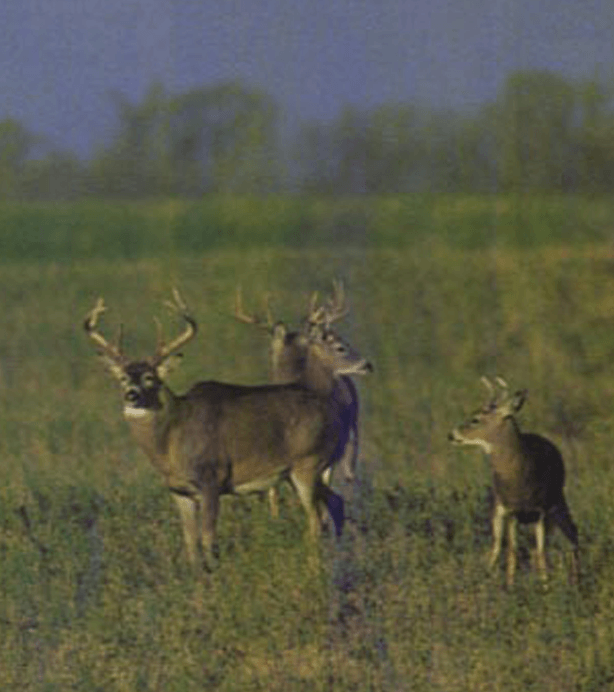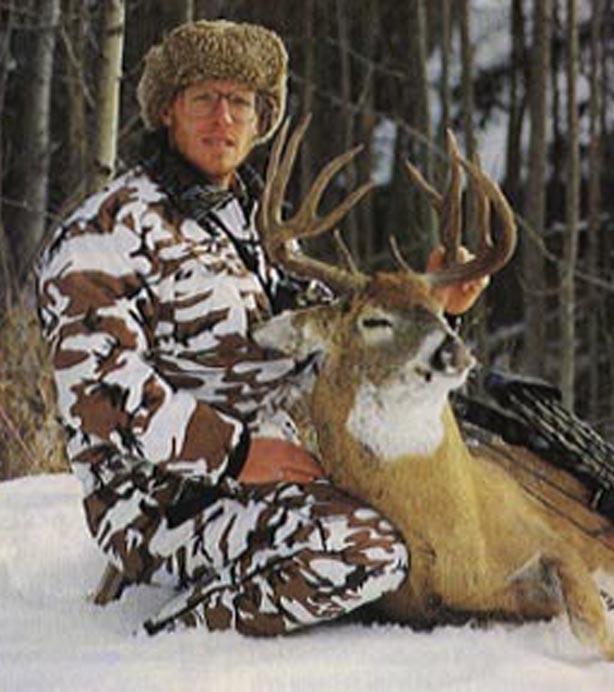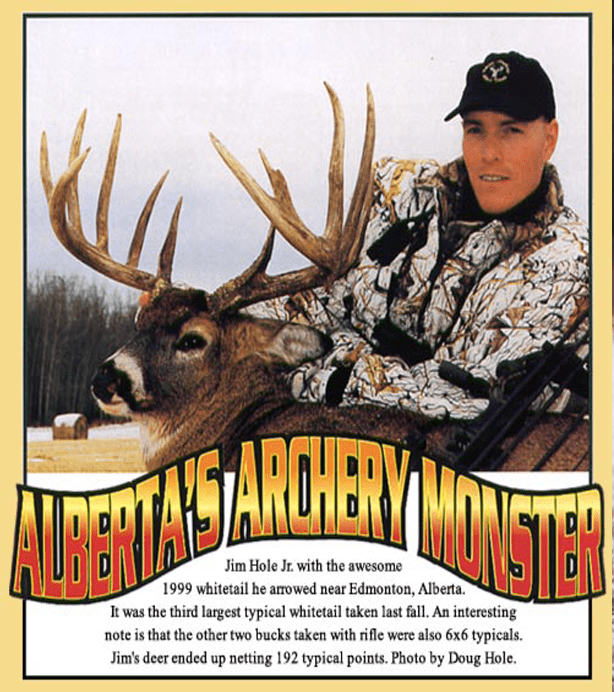In The Bow Zone
by Mark T. Sullivan
(Outdoor Life Magazine, October, 1999)
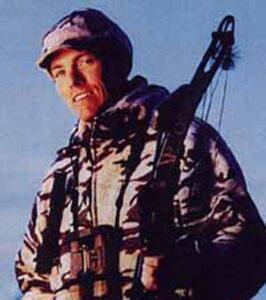

Imagine a 1,600-square-mile tract of hunting land open only to bowhunters. The herd genetics are fabulous, forage is abundant and seeing a 170-class or better whitetail from your stand is a distinct possibility. You’ve just entered…THE BOW ZONE
It’s an hour after dawn on a bitter cold November morning in northern Alberta. Lesley Parks is perched in a tree stand 25 yards from a scraper when a doe jumps the fence bordering a grain field to the north.
The doe trots through the newly fallen snow to the scrape, urinates and then continues on the the southeast. Knowing he is in “The Zone,” Parks stands and mounts his bow. Right in the doe’s tracks a huge whitetail buck exits the grain field. The deer locks up in the scrape, stands on his hind legs and smashes his rack into the branches of the closest tree.
“I’m right on top of him at that point, and let me tell you, it’s an awesome sight,” says Parks, a soft-spoken stonemason from North Carolina. “When he drops down, he spins around with his nose on the ground like a dog on a scent getting ready to go. I put the pin on him and shoot.”
When Parks finds the deer, it sports eight points on one antler, six on the other. The 14-pointer gross-scores in the 160’s on the Pope and Young scale and field-dresses at close to 250 pounds.
Welcome to “The Zone.” The Edmonton Bow Zone.
The Zone, hard by the fifth largest city in Canada, is home to some of the wildest whitetail hunting action imaginable. The 1,635 square mile chunk of terrain has been limited to bow-only hunters since 1974, which means the bucks that live there get a chance to grow old and hornheavy. That fact, combined with the area’s genetics, nutrient-rich soil and <>abundant feed, means the area is crawling with bucks like the one Lesley Parks arrowed that early November morning.
Or the 1971/8 typical Don McGarvey shot as it entered an alfalfa field in The Zone in September 1991. McGarvey’s buck ranks as the No. 4 typical of all time by the P&Y scoring method.
Which is not to say that hunting The Zone is guaranteed easy pickings. “Seventy percent of the area is open field, leaving little cover for either deer or hunter to hide in,” says 37-year-old Jim Hole, who has hunted The Zone since he was a youngster. “And their contact with humans is limited to a farmer sowing or mowing once or twice a year. So you have an animal completely intolerant of infringement on its territory. Make one mistake and these bucks go nocturnal.
Hole is not unlike a drill sergeant as he continues. “Because they are so sensitive to pressure, you need to do at least four dozen things right every time you go out if you’re going to succeed. But if a hunter works hard to do those four dozen things right, he’ll get an opportunity on a Pope and Young whitetail.”
Quite an assertion. But Hole has been outfitting in The Zone for 15 years. In that time, he’s been the tactician behind the taking of more than 60 record-book whitetails, not to mention scores of big deer that have been missed by his rattled clients over the past decade and change.
Indeed, when most people talk about The Zone, they talk about Hole. And when they talk about Hole, they are actually talking about “The Program,” his rigid tactical and philosophical approach to hunting monster whitetails.
“That first time up there, if you try to play the game his way, it’s like Jim hunts through you,” says Chris Green, a New Jersey hunter who has been to The Zone eight times. “Some people don’t like it and rebel. Those are the ones who usually go home empty-handed. The ones who decide to go with The Program usually get their crack at a big deer. But it’s more than that-you learn The Program and you take away a lot of ideas that can work back home.”
A week-long immersion in Hole’s program begins on Sunday afternoon with the examination of every piece of equipment a hunter plans to take into The Zone. Any metal or plastic surface that might clink or clank on the way to, sitting on or walking out from a stand site is wrapped in black hockey tape. The rubberized surface of the tape deadens sound.

Then knapsack-packing methods are critiqued, as are range-finder choices, clothing and bow sights. Because so many of the biggest bucks are seen only under low-light conditions, Hole expects his clients to hunt with a tritium pin and range finder, not peep sights. Next, the novice to Alberta puts on all his cold-weather clothes and demonstrates that he can organize his gear according to Hole’s strictures. Binoculars must be cinched to chests with elastic straps. Bows must snap into a spare arm hook that hangs on the hunter’s left hip. There must be a loop on the hunter’s right hip where Hole’s custom-designed portable tree stand will hang on the hikes, frequently long ones, to and from the hunting areas.
Hole’s tree-stand setup is based on a male-female pin system. Each stand has an aluminum nodule that juts off the back of the seat. It will fit perfectly in all of the more than 100 female receivers he has placed in trees throughout The Zone. Hole devised the system to give his hunters as much flexibility as possible.
But before they can take advantage of that flexibility, a hunter will drill on the practice pin in the yard of the hunting lodge. He must prove to Hole that he can climb the tree and slide the stand into the female fitting in total silence. “Sound carries for miles up here, literally,” Hole says. “Make one wrong noise, especially metal-on-metal contact, and that buck is gone!”
Hole’s approach to bowhunting is like a Wall Street takeover specialist’s: He’s conservative as a rule, and ruthlessly aggressive at the moment it’s time to capitalize. The guy even totes a briefcase into the field. In it he keeps maps and a cross-referenced list of all of his pin sites, as well as a chart that tells him the required wind direction to hunt a specific pin and up-to-date notation as to the last time a human went to that site.

Hole has his stands further subcategorized in terms of what he calls “tolerance.” A high-tolerance stand is one that forgives noise or minor shifts in the prevailing wind currents. The odds are somewhat against the hunter in these stands, which are often in narrow hedgerows or on the edge of fields 200 or more yards from a bedding area.
It was the third week in November a few years back when Mark Stanley was in just such a high-tolerance stand. Shortly after dawn, he saw a huge buck creeping the woodline of the far side of the field he overlooked. Stanley picked up his rattling antlers and crashed them together. The buck raised its head and made a great loop to within 15 yards of Stanley’s position. The basic 5×5 gross-scored 174 points P&Y.
A low-tolerance stand, by way of comparison, is one that’s situated where any noise or shift in the wind will stomp out the likelihood of seeing a big buck. But because such stands are often ambush sites that are close to, or actually within, known bedding areas, the risk can be more than worthwhile.
Just ask John Smith, a Michigan bowhunter who rattled in four monsters in 15 minutes from one such stand five years ago. The biggest one, which Smith figures would have made Pope and Young (more than 170 inches), passed just out of range. Two minutes later, a magnificent eight-pointer strode in and Smith arrowed it. Five minutes after that, two other eight-pointers came in and went to war just below Smith’s stand. Smith got so excited he vomited.
If Hole is intense about stand selection, he is fanatical about how his stands are approached. After he has checked the wind and determined that hunt’s pin site, he tells his clients exactly how they are going to travel from his van to the stand. No one gets out of the van unless they can repeat the approach direction, the prevailing wind and the strategy for the stand.

Hunters are expected to go directly to their pin sites and move straight up their trees without pausing. Hole believes that any time on the ground brings an equal increase in scent pollution. Indeed, he is so obsessed with ground pollution that he often drives hunters to within 10 yards of their evening stands at the edge of grain fields; the deer are used to tire scent because they encounter farm equipment, but they are not used to having humans on the ground near them.
Immediately prior to, or during the peak of, the rut, Hole has his clients rattle three times during each morning’s hunt. An hour after sunrise they tickle the antlers. An hour after that the hunter intensifies the clash of the horns. And an hour later the hunter goes to war. Each sequence is 45 seconds or less.
“We kill 50 percent of these studs rattling or calling,” says Hole.
Hole knows that hunters new to his program often find his demands difficult to master. “It’s a technical hunt which is not easy,” Hole allows. “But if you learn to hunt like this, the rewards can be phenomenal.”
Phenomenal, but not instantaneous. Doug Hole, for example, has been hunting according to his younger brother’s program for years. The week after Parks shot his 14-pointer, Doug rattled in four bucks in a slough bottom. But the deer came in so fast and so close that he didn’t have a chance to raise his bow.
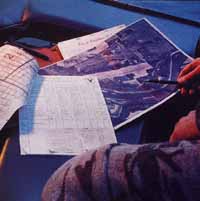
Six days later Doug decided to move uphill into a low-tolerance stand 400 yards north of the slough bottom. It was an evening hunt and 31 degrees below zero. “I had to go 800 yards through thigh-deep snow in total silence to make the stand work,” Doug says. “But I did what Jim talks about all the time and got settled in. Just as it was getting gloomy, a doe appeared from the north. Five minutes behind her, a buck with horns like you wouldn’t believe stepped out. You spend a lot of time in The Zone and you learn that most times the rack follows the buck. With true monarchs the buck has to follow his rack.”
Doug refused to look at the antlers. He forced himself to focus on the tenets of The Program, making sure he could capitalize on opportunity. When the deer stepped behind a clump of bushes, Doug drew. But the deer froze. “I remember asking myself how long I could stay at full draw,” Doug says. “I said, ‘For a buck like this, a long time.'”
When the buck finally stepped out, Doug put the pin behind his shoulder and shot. The nine-pointer wheeled and charged into the field. It crested a hill and died halfway to the slough bottom. The 5×4 gross-scored in the high 160s P&Y. “The key up here in The Zone is to work my brother’s program,” says Doug. “Sooner or later your attention to his details will create luck.”
